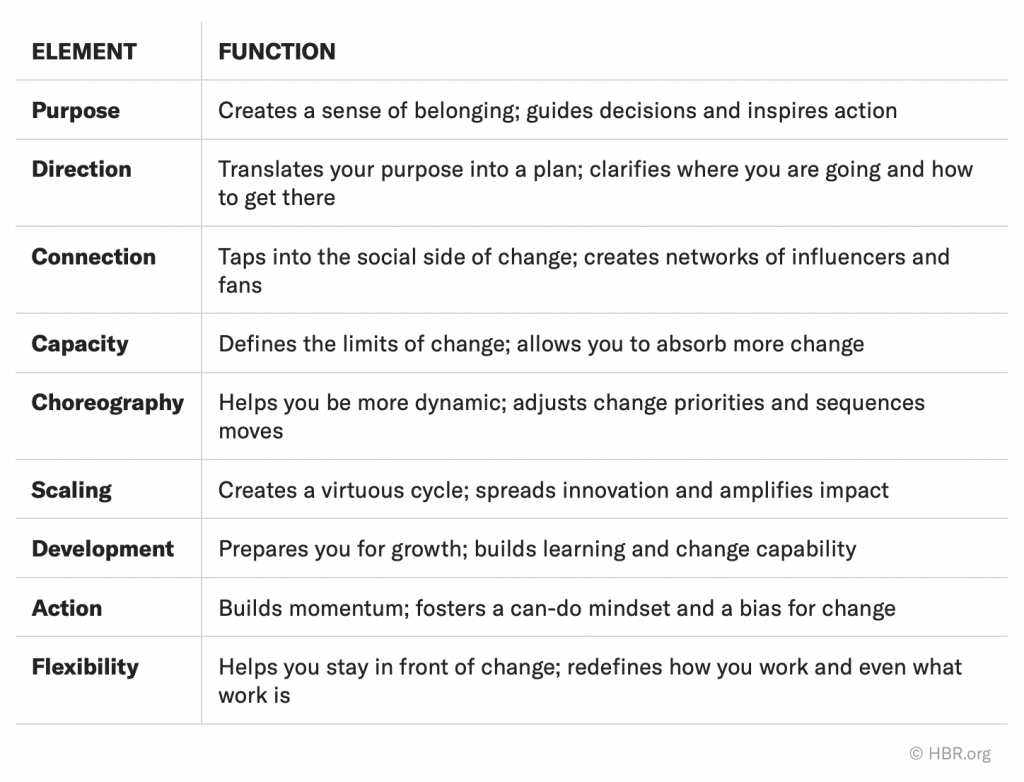DEI and “Change Power”: Winning combination for high performance4 min read
Reading Time: 3 minutesReading Time: 3 minutesBack in 2021, the “Change Power” concept was introduced in an HBR article, emphasizing its impact on financial performance, culture, leadership, and employee engagement. HBR’s survey of nearly 2,000 employees across 37 large global organizations from various industries revealed a significant correlation between a company’s capacity to change (Change Power) and its performance. They discovered that top-quartile companies, in terms of change power, showed twice the profitability and up to three times faster revenue growth than those in the bottom quartile or half of the same industry. A shift to a higher index decile corresponded with substantial margin improvements and total shareholder return. Furthermore, these top-quartile companies also exhibited more decisive leadership and culture, resulting in more inspired and engaged employees, as validated by Glassdoor rankings. Therefore, experts concluded that change power is a crucial metric for companies. By understanding their capacity for change, companies can identify their strengths and weaknesses, compare themselves to competitors, and create targeted strategies to improve adaptability. Since then, companies have increasingly recognized the need to build their “Change power.”
Nine traits and abilities help companies excel at change:
 “Understanding your strengths and weaknesses in these categories allows you to determine your capacity for change and to create a blueprint for increasing it over time.”
“Understanding your strengths and weaknesses in these categories allows you to determine your capacity for change and to create a blueprint for increasing it over time.”
In the year since, experts have discovered a strong correlation between Change Power and Diversity, Equity, and Inclusion (DEI). Companies with high DEI scores on platforms like Glassdoor have 80% higher change power than others. Further analysis of 79 large companies revealed that even a slight improvement in DEI ratings (measured on a 5-point scale) corresponded to a 13% increase in change power on average. Previous research has already established a link between change power and improved EBIT margins, total shareholder return, and revenue growth. While establishing causality may be difficult, we must recognize the connection between these two business components. Companies excelling in DEI tend to have a more robust “Change power”, resulting in better performance, leadership, and employee engagement.
Purpose, choreography, and development are three key elements closely correlated with both components:
Purpose unifies and inspires action, and DEI efforts contribute to an organization’s shared sense of purpose, as demonstrated by Mastercard’s successful expansion into new businesses. The company’s alignment with its mission of “doing well by doing good” facilitated the development of innovative products and DEI-inspired policies, thereby enhancing its adaptability and yielding high DEI and change power scores.
Choreography in an organizational context refers to the ability to sequence actions and adapt dynamically, a crucial asset during periods of change. Adobe exemplified such adaptation with its response to the 2020 murder of George Floyd, implementing DEI initiatives informed by discussions with its Black employees. Adobe’s commitment to incorporating diverse perspectives, a hallmark of successful choreography, boosted its DEI performance and overall resilience to change.
Development, particularly talent development, is essential for building resilience and organizational growth. DEI develops all talent, supports diverse career pathways, and ensures equal growth opportunities. Mastercard underscores how change-centric companies invest in talent development through DEI activities. By incorporating DEI into their learning academies and fostering effective leader feedback, they facilitate diverse growth opportunities. Recent research supports this approach, emphasizing development as a critical element in promoting inclusion.
To accelerate performance by connecting DEI and “Change power,” companies can start by assessing their changeability and DEI status. Then, you can take concrete steps to improve in these areas. Leadership discussions should address strengths and weaknesses compared to competitors. Executives must share a common ambition and commit to taking action. You should intentionally form diverse teams as they are crucial for innovation. By embracing new trends, companies can differentiate themselves and drive meaningful progress. Companies can take action now, distinguishing themselves through their commitment to these two critical areas. As measurement approaches evolve, the importance of DEI and “Change power” will only grow. By capitalizing on this intersection, companies can set themselves apart and thrive in an ever-changing business landscape.
For example, Mastercard has successfully integrated DEI into its operations, aligning with its mission of “doing well by doing good.” The company’s focus on financial inclusion for the unbanked and underserved has resulted in impressive DEI scores and exceptional change power. The evolution of the “Change Power” concept underscores its inherent value for businesses navigating today’s volatile landscape. Our findings reinforce that a company’s ability to adapt, innovatively and swiftly, significantly impacts its financial performance, leadership strength, and culture. Furthermore, a clear correlation has emerged between “Change Power” and Diversity, Equity, and Inclusion (DEI) efforts. The experiences of Mastercard and Adobe illuminate how businesses can intertwine purpose, choreography, and talent development with DEI initiatives to enhance their change capacity. Therefore, as companies strive to remain competitive and agile in the face of continual transformation, understanding and enhancing “Change Power” and DEI must take precedence. Through this strategic alignment, companies can maximize their resilience, foster inclusive growth, and ensure sustainable success in a rapidly evolving business world.




